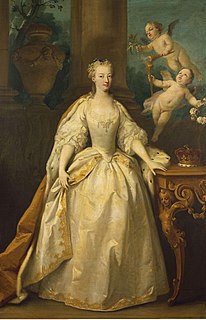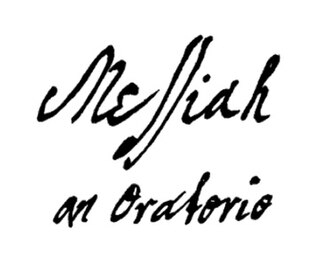Background
The German-born Handel had been resident in London since 1712 and had there achieved great success as a composer of Italian operas. He had also enjoyed the patronage of monarchs Queen Anne, George I and George II and other members of the royal family and had been commissioned by them to compose numerous pieces of music for worship services in the royal chapels as well as for other royal occasions. [2] Handel enjoyed a particularly warm and close relationship with Anne, Princess Royal, eldest daughter of George II, who supported his opera seasons, was an accomplished musician herself, and to whom Handel even gave private lessons - although he did not enjoy teaching, he made an exception in her case. [3] [4] The evening before the wedding, the princess, the rest of the royal family and all their court attended the first performance of a full length operatic entertainment,"Parnasso in Festa", specially composed by Handel for the occasion at the King's Theatre in the Haymarket where he was presenting his seasons of Italian operas, and with the same star opera singers who were appearing in his current successful opera. "Arianna in Creta". [4]
The princess had herself chosen the biblical texts which Handel set to music in the anthem. [5] It is a festive piece with double choruses, i.e., the choral writing is for eight parts rather than the usual four. [6] During the wedding service, while the performance of Handel's anthem was taking place there were no processions or ceremonies or other activities happening; the order of service indicated this was the only time the princess and her bridegroom sat in the chairs provided for them. They and everyone else present gave Handel's music their full attention. [7]

George FridericHandel was a German-born Baroque composer becoming well known for his operas, oratorios, anthems, concerti grossi and organ concertos. Handel received his training in Halle and worked as a composer in Hamburg and Italy before settling in London in 1712, where he spent the bulk of his career and became a naturalised British subject in 1727. He was strongly influenced both by the middle-German polyphonic choral tradition and by composers of the Italian Baroque.

Anne, Princess Royal and Princess of Orange was the second child and eldest daughter of King George II of Great Britain and his consort Caroline of Ansbach. She was the spouse of William IV, Prince of Orange, the first hereditary stadtholder of all seven provinces of the Northern Netherlands. She was Regent of the Netherlands from 1751 until her death in 1759, exercising extensive powers on behalf of her son William V. She was known as an Anglophile, due to her English upbringing and family connections, but was unable to convince the Dutch Republic to enter the Seven Years' War on the side of the British. Princess Anne was the second daughter of a British sovereign to hold the title Princess Royal. In the Netherlands she was styled Anna van Hannover.

Samson is a three-act oratorio by George Frideric Handel, considered one of his finest dramatic works. It is usually performed as an oratorio in concert form, but on occasions has also been staged as an opera. The well-known arias "Let the bright Seraphim", "Total eclipse" and "Let their celestial concerts" are often performed separately in concert.
Zadok the Priest is a British anthem which was composed by George Frideric Handel for the coronation of King George II in 1727. Alongside The King Shall Rejoice, My Heart is Inditing and Let Thy Hand Be Strengthened, Zadok the Priest is one of Handel's Coronation Anthems. One of Handel's best-known works, Zadok the Priest has been sung prior to the anointing of the sovereign at the coronation of every British monarch since its composition and has become recognised as a British patriotic anthem.

Israel in Egypt is a biblical oratorio by the composer George Frideric Handel. Most scholars believe the libretto was prepared by Charles Jennens, who also compiled the biblical texts for Handel's Messiah. It is composed entirely of selected passages from the Old Testament, mainly from Exodus and the Psalms.

Saul is a dramatic oratorio in three acts written by George Frideric Handel with a libretto by Charles Jennens. Taken from the First Book of Samuel, the story of Saul focuses on the first king of Israel's relationship with his eventual successor, David; one which turns from admiration to envy and hatred, ultimately leading to the downfall of the eponymous monarch. The work, which Handel composed in 1738, includes the famous "Dead March", a funeral anthem for Saul and his son Jonathan, and some of the composer's most dramatic choral pieces. Saul was first performed at the King's Theatre in London on 16 January 1739. The work was a success at its London premiere and was revived by Handel in subsequent seasons. Notable modern-day performances of Saul include that at Glyndebourne in 2015.

The ways of Zion do mourn / Funeral Anthem for Queen Caroline, HWV 264, is an anthem composed by George Frideric Handel. It was first performed at the funeral of the Queen at Westminster Abbey on 17 December 1737. Handel slightly re-worked the anthem and used it for the opening section of his oratorio Israel in Egypt in 1739. The theme of the first chorus was taken by Mozart as the theme for the Requiem aeternam movement of his Requiem Mass. The anthem is approximately forty minutes in length.

Solomon, HWV 67, is an English oratorio by George Frideric Handel. The anonymous libretto – currently thought to have been penned by the English Jewish poet/playwright Moses Mendes (d.1758) – is based on the biblical stories of the wise king Solomon from the First Book of Kings and the Second Book of Chronicles, with additional material from Antiquities of the Jews by ancient historian Flavius Josephus. The music was composed between 5 May and 13 June 1748, and the first performance took place on 17 March 1749, with Caterina Galli in the title role at the Covent Garden Theatre in London, where it had two further performances. Handel revived the work in 1759.
The term festa teatrale refers to a genre of drama, and of opera in particular. The genre cannot be rigidly defined, and in any case feste teatrali tend to be split into two different sets: feste teatrali divided by acts are operas, while works in this genre performed without division, or merely cut into two parts, are serenatas. A festa teatrale is a dramatic work, performed on stage.
As pants the hart is an anthem composed by George Frideric Handel for the Chapel Royal of Queen Anne and subsequently revised. There are five versions of the work, the first being completed in 1713, and the final in 1738. HWV 251a was the first anthem Handel composed for the Chapel Royal.

The Handel organ concertos, Op. 4, HWV 289–294, are six organ concertos for chamber organ and orchestra composed by George Frideric Handel in London between 1735 and 1736 and published in 1738 by the printing company of John Walsh. Written as interludes in performances of oratorios in Covent Garden, they were the first works of their kind for this combination of instruments and served as a model for later composers.

Baroque music of the British Isles bridged the gap between the early music of the Medieval and Renaissance periods and the development of fully fledged and formalised orchestral classical music in the second half of the eighteenth century. It was characterised by more elaborate musical ornamentation, changes in musical notation, new instrumental playing techniques and the rise of new genres such as opera. Although the term Baroque is conventionally used for European music from about 1600, its full effects were not felt in Britain until after 1660, delayed by native trends and developments in music, religious and cultural differences from many European countries and the disruption to court music caused by the Wars of the Three Kingdoms and Interregnum. Under the restored Stuart monarchy the court became once again a centre of musical patronage, but royal interest in music tended to be less significant as the seventeenth century progressed, to be revived again under the House of Hanover. The Baroque era in British music can be seen as one of an interaction of national and international trends, sometimes absorbing continental fashions and practices and sometimes attempting, as in the creation of ballad opera, to produce an indigenous tradition. However, arguably the most significant British composer of the era, George Frideric Handel, was a naturalised German, who helped integrate British and continental music and define the future of the classical music of the United Kingdom that would be officially formed in 1801.

George Frideric Handel was the house composer at Cannons from August 1717 until February 1719. The Chandos Anthems and other important works by Handel were conceived, written or first performed at Cannons.

Carlo Scalzi was an Italian castrato who had an active performance career in major opera houses in Italy from 1718-1738. He was also heard in London in 1733–1734 where he notably created the role of Alceste in the world premiere of George Frideric Handel's Arianna in Creta. The librettist Pietro Metastasio described Scalzi as a "very unique (sic) singer" and likened his voice to that of the famous castrato Farinelli.

Messiah, the English-language oratorio composed by George Frideric Handel in 1741, is structured in three parts, listed here in tables for their musical setting and biblical sources.

Sing Unto God/Anthem for the Wedding of Frederick, Prince of Wales and Princess Augusta of Saxe-Gotha,(HWV 263), is an anthem composed by George Frideric Handel. It was performed for the royal wedding on 27 April 1736 at the Chapel Royal in St James's Palace, London with Francesca Cuzzoni-Sandoni, Carlo Broschi "Farinelli", and Francesco Bernardi "Senesino". The text was adapted from verses of Psalms 68, 106 and 128

Parnasso in festa, per li sponsali di Teti e Peleo, by George Frideric Handel, is a festa teatrale, a form also called a "serenata", a type of Italian opera intended as entertainment to celebrate a festive royal or state occasion. The work was written to celebrate the marriage of Anne, Princess Royal and Prince William of Orange. Parnasso in festa had its first performance in London at the King's Theatre on 13 March 1734 and was repeated five times. The operatic entertainment, to an anonymous libretto, was such a success at its London premiere that although it was intended as a one-off production for a royal wedding, Parnasso in festa was revived by Handel in several subsequent seasons.

The Foundling Hospital Anthem, also known by its longer title "Blessed are they that considereth the poor" [sic], is a choral anthem composed by George Frideric Handel in 1749. It was written for the Foundling Hospital in London and was first performed in the chapel there. Handel wrote two versions, one for choir only and one for choir and soloists. Composed 10 years before his death, it was Handel's last piece of English church music.

Chandos Anthems, HWV 246–256, is the common name of a collection of eleven anthems, sacred choral compositions written by George Frideric Handel, with the authorship of No. 12 being debated. The texts are psalms and combined psalm verses in English. Handel wrote the anthems as composer in residence at Cannons, the court of James Brydges, who became the First Duke of Chandos in 1719. His chapel was not yet finished, and services were therefore held at St Lawrence in Whitchurch. The scoring is intimate, in keeping with the possibilities there. Some of the anthems rely on earlier works, and some were later revised for other purposes.








